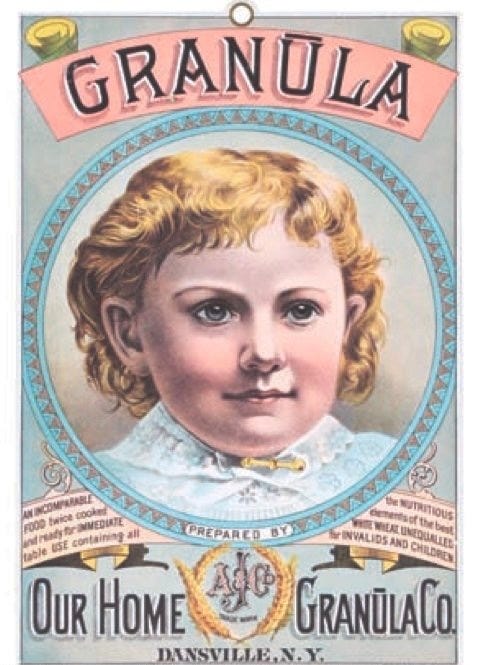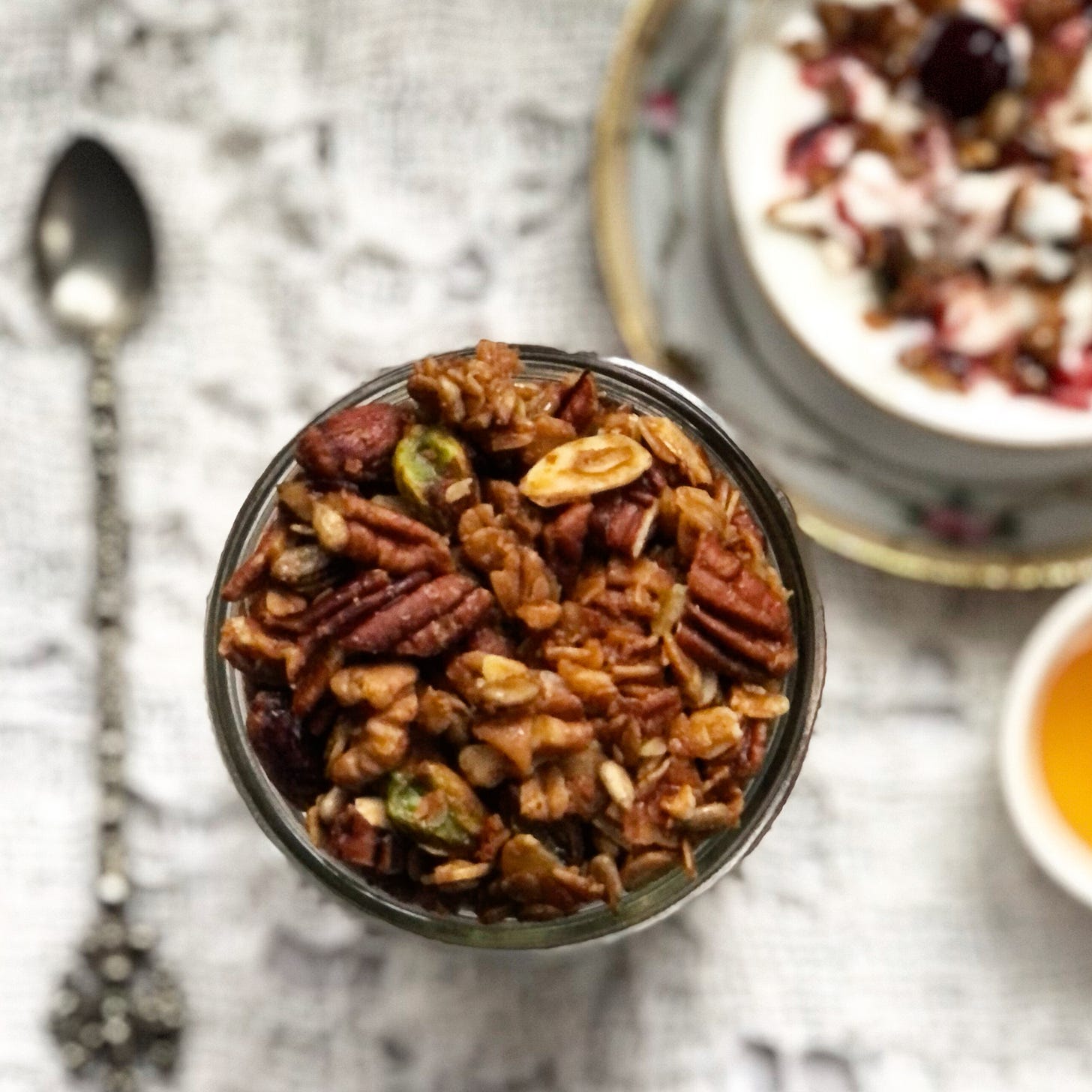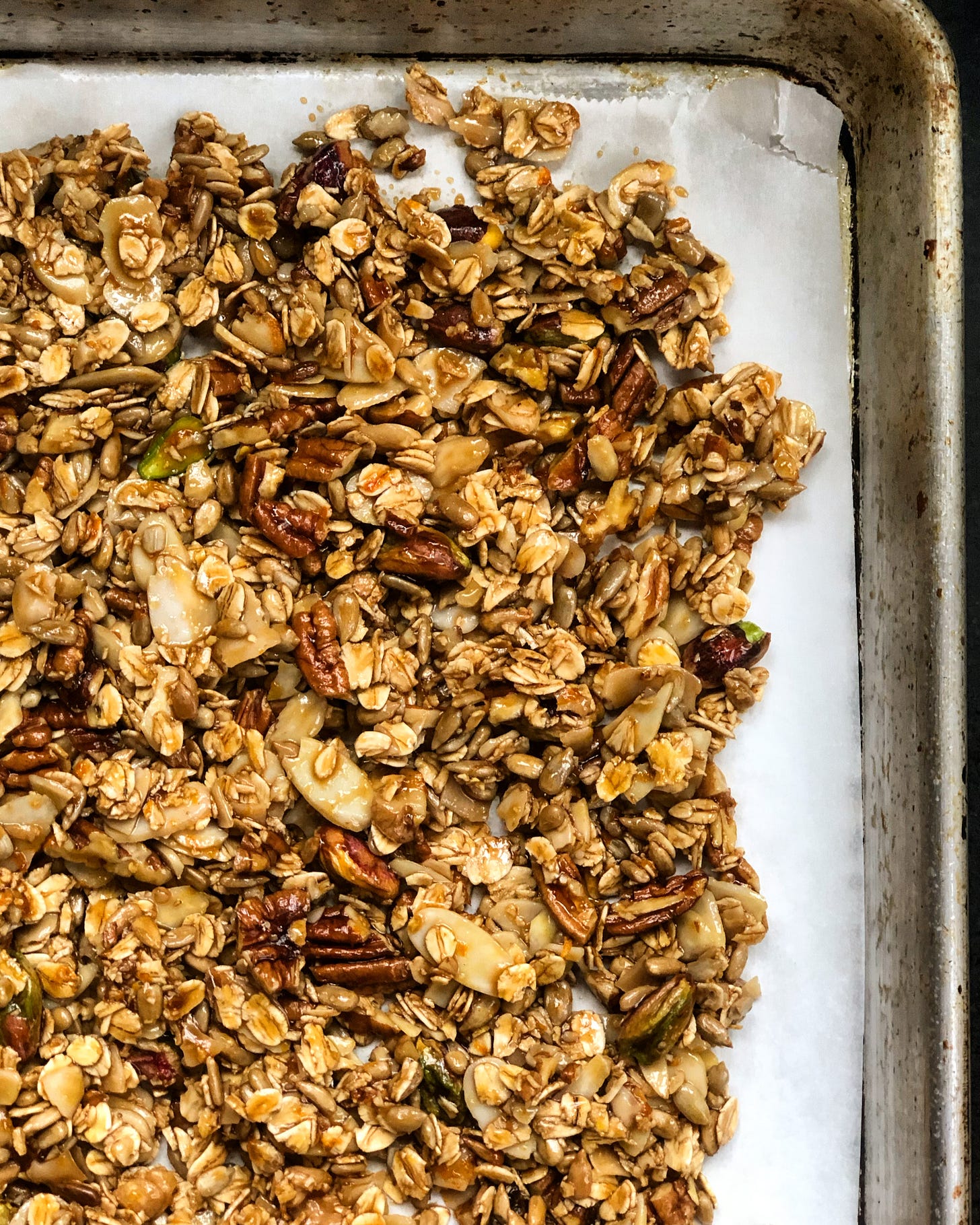It’s not where you take things from - it’s where you take them to
Jean-Luc Godard, filmmaker
What is an original? An original thought, idea, recipe, piece of art, fashion design?
I was thinking about that this week as I was making granola, tweaking and adjusting the recipe as I went.
Granola was first called granula by its inventor, Dr. Caleb Jackson, who created it as a healthy breakfast alternative in 1863. Made of graham flour baked into sheets that were broken down and rebaked several times, the end product had to be soaked in milk overnight to be edible.
Milk and cereal - a completely original idea that sparked a breakfast revolution.
The concept of healthy grains for breakfast owes its next iteration to Dr. John Kellogg. Kellogg is usually credited with the creation of granola, a name he trademarked in 1878 (after Jackson threatened him with a lawsuit). Kellogg’s version used rolled oats and wheat flour and soon he was selling two tons of the stuff a week. That eventually led to cornflakes. I suspect Tony the Tiger and sugar-frosted flakes were not part of the original vision.
Then came C.W. Post. Post had granola while he was a patient at Kellogg’s sanitarium in the late 1800s. Fascinated by the sanitarium’s all-grain diet, Post first created Postum, an all-grain coffee substitute and then Grape-nuts in 1897. Post’s daughter, Marjorie Merriweather Post, would go on to helm a food empire to rival Kellogg’s (you can read here about the formidable Marjorie, who married four times, ran the business for 40 years, built Mar-a-Lago, foresaw the potential of frozen food dinners in 1929, and died a billionairess).
If you want to have good ideas you must have many ideas. Most of them will be wrong, and what you have to learn is which ones to throw away.
Linus Pauling, Noble Prize-winning biochemist
So what does this have to do with my granola?
In a recent recipe development workshop I did with Susan Spungen, we talked about the idea of an “original” recipe. As she wisely observed, while your recipe may not be a “first”, what you create is the result of how you were inspired - your take on that original good idea. “Ignore the noise,” she advised. “Stay true, be authentic to your unique perspective. That is what creates an original recipe.”
Imagine what would have happened if Kellogg didn’t take Jackson’s concept further?
Perhaps the most important thing about ideas and creativity and originality is that there will be many more failures than successes. As Pauling observes above and as Spungen told us, the trick about ideas is knowing which ones to keep and which ones to throw out. “There’s only one way to find out whether something will work or not, and that’s to try it and fail first,” she added.
In the end, good ideas are always the product, and the benefactors, to one degree or another, to what has come before.
When I searched for granola recipes online, I got back 73,500,000 results. While many will be the same thing, presented different ways, many many more will be granola with a personal twist: more pecans; less honey; skip the coconut; use date syrup; add cinnamon. That granola will be slightly different every time, under every hand that makes it. And all will be wholly original ideas sparked by some dry sheets of graham flour first made in 1863.
My favourite granola
serves 4, with delicious leftovers
Forget Jackson and Kellogg. The genesis of this particular granola is from Fortnum and Mason, or rather the absolutely smashing cookbook that Tom Parker Bowles wrote about F+M in 2016. The beauty of granola is its absolute flexibility. Don’t like pecans? Add more almonds. Love raisins? Stir them in at the end so they don’t dry out while baking. The possibilities are endless, which is the root of originality.
Ingredients
4 tablespoons/55 grams unsalted butter
3 tablespoons/60 grams honey
1 1/2 tablespoons golden syrup or date syrup
1/2 cup/85 grams Demerara sugar
1 teaspoon vanilla extract
1/2 teaspoon fine sea salt
grated zest of two tangerines or oranges, plus the juice of one tangerine or orange (optional)*
1/3 cup/40 grams chopped walnuts
3/4 cup/75 grams chopped pecans
1/3 cup/40 grams raw pistachios
2/3 cup/50 grams flaked almonds
1/2 cup/70 grams raw sunflower seeds
1 1/2 cups/125 grams rolled oats
*the addition of citrus is optional, but adds a lovely fresh flavour
Line a large rimmed 13x18 baking sheet, or two smaller rimmed baking sheets, with parchment paper. Heat the oven to 300F/150C.
Put the butter, honey, golden syrup, sugar, salt, vanilla, tangerine zest and tangerine juice in a small saucepan over low heat. Stir until the ingredients are all blended and the sugar dissolved. Set aside.
Combine all of the dry ingredients in a large bowl and stir until combined. Pour half the liquid mixture into the dry ingredients and stir to combine. Pour in the rest of the liquid mixture into the bowl and mix until everything is throughly coated (your hands are a good tool for this!).
Spread the granola evenly in the prepared baking sheet. Bake for 45 minutes to 1 hour, turning the granola every 15 minutes or so, until the mixture is golden brown. Leave the granola to cool on the baking sheet for 10 minutes, and then break it up with your hands until the granola is separated into small granules. Store in an airtight container.
To serve:
Top plain yogurt with the granola, and add fresh berries, dried fruits, a drizzle of honey or a squeeze of tart cherry juice concentrate. Or just eat it by the handful - it’s a perfect energy boost any time of the day.








You left out a fun fact: granola had a resurgence in popularity after Woodstock, where it was airdropped to concert goers so they’d have something to eat. Hence the association between hippies and granola. Or so the story goes.